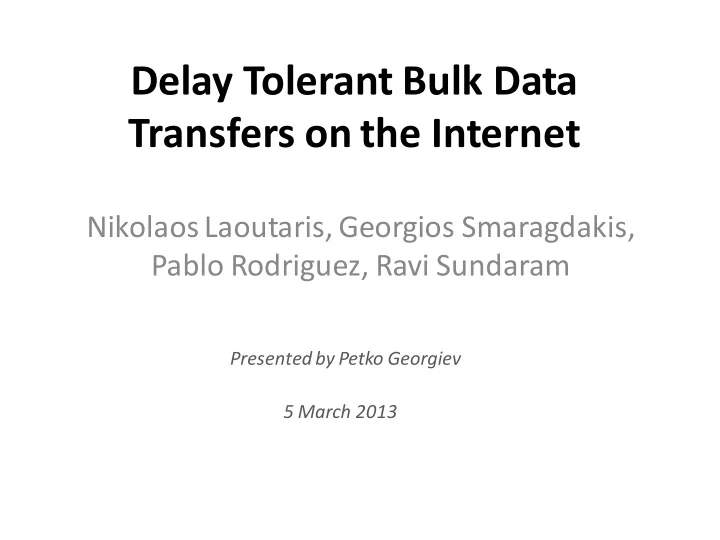

Delay Tolerant Bulk Data Transfers on the Internet Nikolaos Laoutaris, Georgios Smaragdakis, Pablo Rodriguez, Ravi Sundaram Presented by Petko Georgiev 5 March 2013
Motivation • There are important applications requiring exchange of Delay Tolerant Bulk data (TBytes): – CERN’s Large Hadron Collider – Large data centers – Rich media transfers • Current solutions: – Expensive dedicated networks – Postal service
Goals • Use existing commercial ISP capacity infrastructure • Avoid increasing transit cost • Avoid reducing QoS for interactive traffic
Contributions • Ideas: – Transmit during off-peak hours – Do not impact charged volume of sender’s/receiver’s access ISP • Two situational policies that perform DTB data transfers for free (or at minimized cost) • Performance analysis • Cost analysis
Network Model Figure 1: Sender (u) and receiver (v) of DTB traffic
Idea • 95-percentile pricing – x ≡ time series of 5 -minute transfer volumes – Charged volume: q(x) ≡ 95 -percentile value of x • Pricing is determined by peak transfers and NOT total volume! • Use off-peak hours to fill capacity with DTB
Approach: Water Filling C ≡ capacity x ≡ time series of volume transfers t ≡ time slot f(C, x, t) ≡ DTB data
Approach: Water Filling (cont’d) • Volume of DTB traffic pushed through a charged link of capacity C carrying background traffic x in the interval [t 0 , t 0 +T) without increasing its charged volume q(x)
Policy: End-to-End with Source Scheduling • Policy is essentially pipelining • Respect both sender’s and receiver’s charged volume
Policy: Store-and-Forward • Independent water-fillings in the two charged links: – ISP(v) → TR (sender uplink) – TR → ISP(u) (receiver downlink)
Policies: Meeting Deadlines • Problem: The target volume B cannot be sent for free within time T • Solution: Solve an optimization problem – Find charged volumes q v > q(x v ) and q u > q(x u ) to minimize the extra transit cost c v (q v ) – c v (q(x v )) + c u (q u ) – c u (q(x u )) – Predict x based on daily traffic patterns of previous week
Results: Free DTB Transfers Figure 3a: F(E2E-Sched) vs. F(SnF) 280 links with C > 1 Gbps
Results: Time Zone Difference Figure 3b: F(E2E-Sched) / F(SnF) ratio as a function of the time difference between sender and receiver
Results: Off-peak Capacity Differences Figure 3c: Influence of off-peak capacity dissimilarity on SnF performance
Results: Advantage of SnF Policy
Results: Storage Node Cost • Cost of storage server and maintenance amortized to less than 1K $ per month • Cost of E2E Scheduling around 60K $ per month
Results: SnF vs. Courier Services Compute amortized daily cost for all sender-receiver pairs Compute daily cost of shipping hard drives (FedEx services)
Summary • If B is the target DTB data volume, then – B < F(E2E-Sched) : transfer for free – F(E2E-Sched) < B < F(SnF) : transfer at zero transit cost (but pay for storage) – F(SnF) < B : SnF can minimize transit cost
Related Work • QBone Scavenger Service – does not protect from high transit cost – does not guarantee delivery under deadlines • Slurpie protocol (application layer) – suitable for one-to-many distribution • Mobile networks – scheduling differs because cost is not considered – nodes are mobile and not static
Future Work • Data encoding • Error recovery • Multiplexing concurrent DTB jobs • Utilizing multiple up/down links for transfer • Survey of how changing market policies will affect the applicability of the model
Criticism • Advantage of SnF seems situational – Time zone differences of > 5 hours – Comparable off-peak capacities • Storage node deployment – Is it really never a bottleneck? – How is it positioned to avoid triangular routing? – Single point of failure
Criticism • Very few details on the “load valleys” • More example DTB transfer volumes needed • Not all pricing information is transparent – E.g. server and maintenance cost estimation
Overall impressions • A nice simple idea of water-filling • It is hacking the traffic volume charging • A lot of evaluation scenarios covered • Needs future work to be production ready
Recommend
More recommend